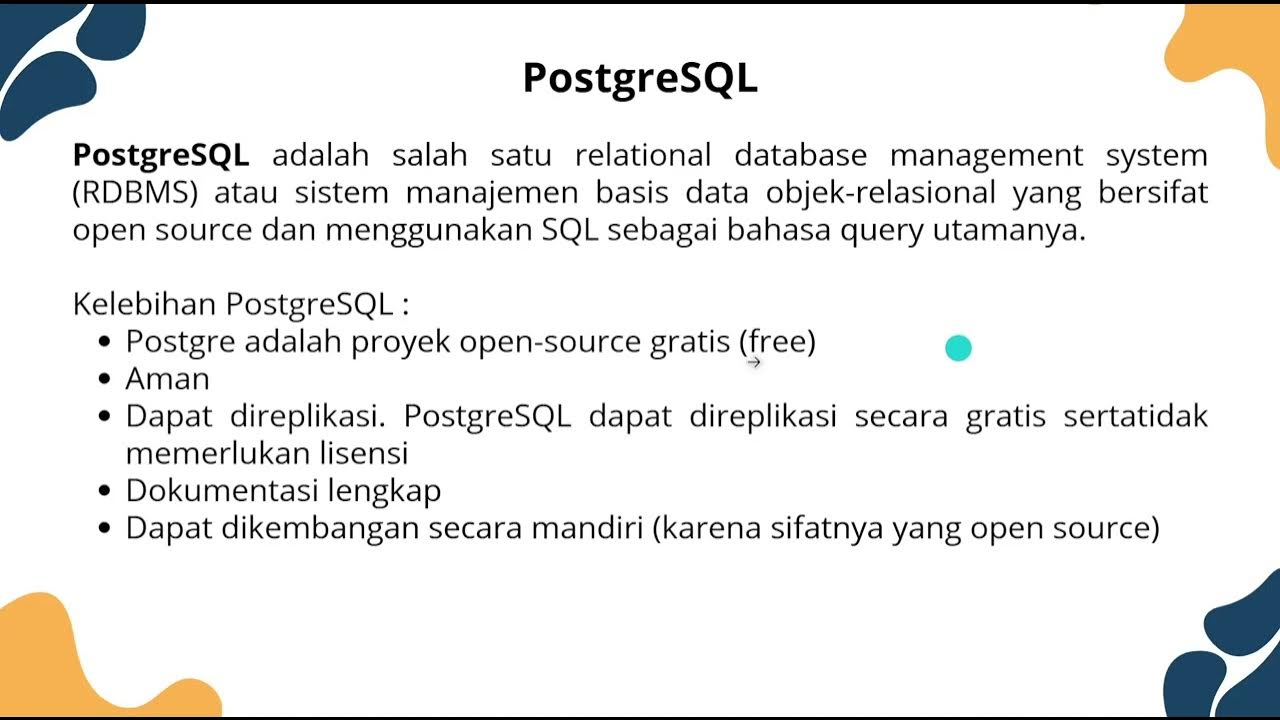Explicação Atividade 1 - Banco de Dados NoSQL - 51/2024
Summary
TLDRIn this video, Professor Maurício discusses the importance of comparing database management systems (DBMS) in SQL. He emphasizes the need for developers and organizations to understand the unique characteristics of each DBMS to make informed decisions. The task involves creating a comparative table of five key databases, detailing their features, advantages, disadvantages, and licensing types. Additionally, students are asked to choose one DBMS for further exploration and justify their selection based on the comparison. The activity aims to provide valuable insights into selecting the right database for specific needs in a constantly evolving technological landscape.
Takeaways
- 😀 Importance of comparative analysis of database management systems (DBMS) to understand their specific features and advantages.
- 😀 Knowledge of different DBMS options helps developers and organizations make informed decisions based on their needs.
- 😀 Choosing the right DBMS is crucial for creating efficient, scalable, and agile systems.
- 😀 Understanding each DBMS's strengths and weaknesses aids in anticipating potential challenges.
- 😀 The task requires creating a comparative table of five major DBMS options available in the market.
- 😀 The comparative table should include columns for the database name, description, key functionalities, advantages, disadvantages, and licensing type.
- 😀 A suggested resource for choosing the DBMSs is db.com, which lists the most popular options in the market.
- 😀 There are relational and non-relational databases available, such as MySQL, MongoDB, and Cassandra, among others.
- 😀 You need to provide references for each DBMS selected, including the sources of information such as websites, books, or articles.
- 😀 After completing the comparative table, choose one DBMS that you would prefer to use and justify your selection based on the table's details.
- 😀 The task is designed to help students understand DBMS features, enabling them to make educated decisions in their professional careers.
Q & A
Why is it important to analyze and compare different database management systems (DBMS)?
-Analyzing and comparing different DBMS is crucial because it helps developers and organizations understand the unique features, functionalities, advantages, and limitations of each system. This knowledge enables informed decisions about selecting the best technology for specific needs, ensuring the development of agile, scalable, and efficient systems.
What is the primary task for the study activity mentioned in the script?
-The primary task involves creating a comparative table of the five most popular database management systems available in the market. The table should include columns such as the name of the database, its description, main functionalities, advantages, disadvantages, and the type of license used by each DBMS.
What columns should be included in the comparison table for each DBMS?
-The comparison table should contain the following columns: name of the database, description of the database, main functionalities, advantages, disadvantages, and the type of license used by the DBMS.
How should students select the five DBMS for comparison?
-Students can select the five DBMS by referencing a website like db.com, which lists the most widely used databases. They can choose from relational and non-relational databases, including options like MongoDB, Redis, ElasticSearch, Cassandra, and others.
What is the significance of including references for each DBMS selected?
-Including references for each DBMS is important to provide credibility and transparency. It shows where the information was sourced from, whether it be websites, books, academic articles, or other relevant materials, helping validate the research and ensuring the quality of the content.
What should students do after completing the comparison table?
-After completing the comparison table, students should choose one of the DBMS systems from the list and justify their choice. The justification should be based on the information provided in the table, detailing the features, advantages, and the context in which the system would be most suitable.
What is the purpose of the justification section in the activity?
-The justification section allows students to explain their reasoning for selecting a particular DBMS, using the data from the comparison table to highlight why it is the best choice for a specific context or need.
Why is it important to stay informed about evolving technologies in DBMS?
-Staying informed about evolving technologies in DBMS is essential because technology is constantly advancing. Choosing the right DBMS can significantly impact the performance, scalability, and efficiency of a system, making it crucial to select the most suitable one as per the current technological landscape.
What are some examples of non-relational databases mentioned in the script?
-Some examples of non-relational databases mentioned in the script include MongoDB (MB), Redis, ElasticSearch, Cassandra, and HBase.
What role do advantages and disadvantages play in the comparison of DBMS systems?
-The advantages and disadvantages help identify the strengths and weaknesses of each DBMS, allowing for a better understanding of how each system performs in various contexts. This information is vital for making informed decisions when selecting the right DBMS for specific requirements.
Outlines

Esta sección está disponible solo para usuarios con suscripción. Por favor, mejora tu plan para acceder a esta parte.
Mejorar ahoraMindmap

Esta sección está disponible solo para usuarios con suscripción. Por favor, mejora tu plan para acceder a esta parte.
Mejorar ahoraKeywords

Esta sección está disponible solo para usuarios con suscripción. Por favor, mejora tu plan para acceder a esta parte.
Mejorar ahoraHighlights

Esta sección está disponible solo para usuarios con suscripción. Por favor, mejora tu plan para acceder a esta parte.
Mejorar ahoraTranscripts

Esta sección está disponible solo para usuarios con suscripción. Por favor, mejora tu plan para acceder a esta parte.
Mejorar ahora5.0 / 5 (0 votes)






